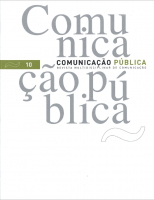The challenges of the new communication age
DOI:
https://doi.org/10.4000/cp.404Palavras-chave:
communication, public relations, new technology, context, levelsResumo
The challenges posed by the digital network revolution, globalisation and the empowerment of stakeholders (Arthur W. Page Society, 2007), combined with other events such as the global economic recession and a loss of trust in organisations, poses significant issues and opportunities for public relations practitioners. This paper explores the challenges of the new communication age by examining seismic shifts in the context in which organisations operate and the consequent changes in role that this requires of public relations practitioners. It concludes by postulating the contribution that practitioners can make at four levels within organisations and concludes that this is a time of significant opportunity for the profession. The main barrier for taking up that opportunity is the capability of practitioners.
Downloads
Referências
Aldrich, H. and Herker, D. (1977). Boundary-Spanning Roles and Organisational Structure. Academy of Management Review, 2, 217-230
Arthur W. Page Society (2007). The Authentic Enterprise. New York: Arthur W. Page Society
Campbell, A. (2008). Strategic Communication in the 24 Hour Media Age. Speech given at Communicate 08, National NHS Communications Conference, London, 5th November 2008
Edleman (2010). Trust Barometer. New York: Edleman
Gregory, A. (2007). Engaging Stakeholders in Emergent Corporate Brands. Journal of Marketing Management, 23 (1-2), 59-73
Gregory, A. (2009). Disconnection and Community: Reflection of Public Relations in the Credit Crunch. Ethical Space: International Journal of Communication Ethics. 6, 69-74
Ipsos MORI (2001) Annual Corporate Responsibility Report. London: Ipsos MORI.
ITC (2010). Measuring the Information Society. Geneva: International Telecommunications Union.
Laurati, F. (2008). Institutionalising Public Relations. Plenary Panel, European Public Relations Education and Research Association. Milan, October 2008
Mayo, A. J. and Noria, N. (2005) Zeitgeist leadership. Harvard Business Review, 83, (10), 45-60
Murray, K. and White, T. (2004) CEO Views on Reputation Management. A Report on the Value of Public Relations as Perceived by Organisational Leaders. London: Bell
Nessman, K. (2000). The Origins and Development of Public Relations in Germany and Austria. In D. Moss, D. Vercic and G. Warnaby (Eds) Perspectives on Public Relations Research. London: Routledge
O’Neill, S.J. (2008). World Class Communications: A View from Primary Care Trust Chief Executives. Report for Centre for Public Relations Studies. Birmingham: Multi Communications DOI : 10.4324/9780203192924 good / bad
Pottinger Econsultancy (2010). 20+ Mind-blowing Social Media Statistics. Available from www.econsultancy.com//blog/. Accessed 25.05.2010
Steyn, B (2007). Contribution of Public Relations to Organisational Strategy Formation. In E. Toth (Ed). The Future of Excellence in Public Relations and Communication Management. Mahwah, NJ: Lawrence Erlbaum Associates
Van Riel, C.B.M. (1995). Principles of Corporate Communication. London: Prentice Hall
White, J. and Dozier, D. (1992). Public relations and decision-making. In J.E. Grunig, L. Grunig and D. Dozier (Eds). Excellence in public relations and communication management. Mahwah, NJ: Lawrence Erlbaum Associates.
Downloads
Publicado
Edição
Secção
Licença
Direitos de Autor (c) 2011 Copyright (c) 2011 Author

Este trabalho encontra-se publicado com a Licença Internacional Creative Commons Atribuição-NãoComercial 4.0.
Os conteúdos da Comunicação Pública estão licenciados com uma licença Creative Commons - Atribuição-NãoComercial 4.0 Internacional.




